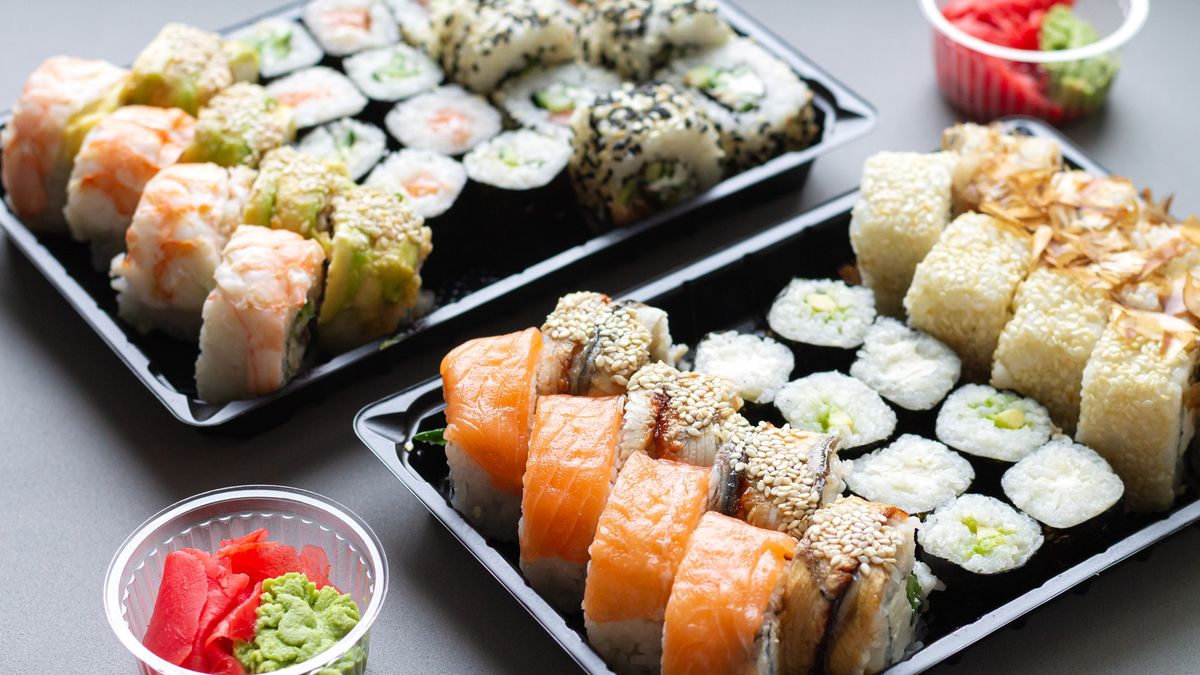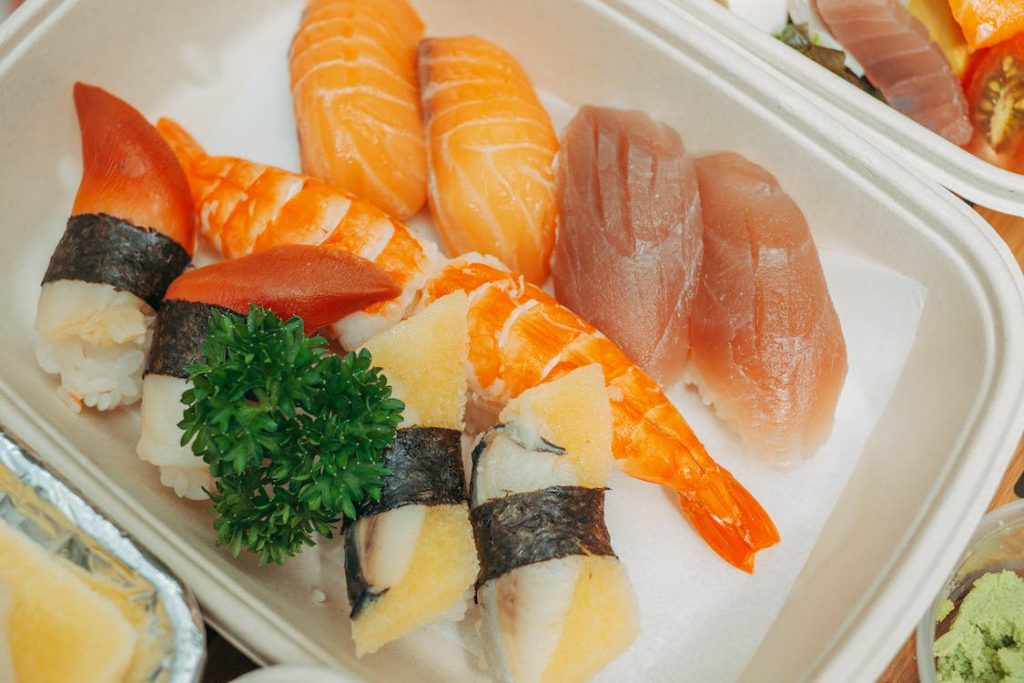Understanding Sushi Safety Guidelines

When it comes to sushi, it’s important to follow certain safety guidelines to ensure that you’re consuming fresh and safe food. These guidelines focus on two key aspects: freshness and temperature control. Freshness is crucial in sushi because raw fish can spoil quickly if not handled properly. Temperature control is important to prevent bacterial growth, as sushi should be stored at the right temperature to maintain its freshness and prevent foodborne illnesses. By understanding these guidelines, you can enjoy sushi safely, knowing that it has been prepared and stored correctly.
Sushi Safety Guidelines For Freshness
To maintain the freshness of sushi, it is important to follow certain guidelines. Firstly, ensure that the ingredients used for sushi are fresh. This includes seafood, vegetables, and rice. Use the freshest fish possible and store it properly to prevent spoilage. Additionally, make sure that the sushi is made just before serving to ensure maximum freshness. It is also crucial to use clean utensils and work in a clean environment to prevent any contamination. Following these guidelines will ensure that the sushi you consume is fresh, safe, and delicious.
Sushi Safety Guidelines For Temperature Control
To ensure the safety of sushi, it is crucial to follow temperature control guidelines. Sushi should be kept at a temperature below 40°F (4°C) to prevent bacterial growth. When serving sushi, it should be kept on ice or in a refrigerated display case to maintain its freshness. If sushi is left at room temperature for more than two hours, it becomes susceptible to bacterial contamination. It is essential to monitor and maintain the temperature of sushi during storage, transportation, and serving to minimize the risk of foodborne illnesses.
How Long Can Sushi Sit Out Before It Goes Bad?

Sushi is a delicacy that requires careful handling and storage to maintain its freshness and quality. When left at room temperature, sushi can go bad and become unsafe to consume. It is important to adhere to food safety guidelines and not let sushi sit out for too long.
According to experts, sushi should not be left at room temperature for more than two hours. After this time, bacteria can start to grow, which can lead to foodborne illnesses. To ensure the safety of sushi, it is recommended to either consume it within two hours or refrigerate it promptly.
By following proper storage practices and not letting sushi sit out for extended periods, you can enjoy this delicious dish without compromising your health. Remember to always prioritize food safety to avoid any potential risks.
Factors Affecting Sushi’s Shelf Life
The longevity of sushi is influenced by several factors that affect its shelf life. The type of ingredients used in sushi plays a significant role in determining how long it can stay fresh. Raw fish, a common sushi ingredient, should ideally be consumed within 24 hours to ensure its freshness and minimize the risk of bacterial growth. Sushi that contains cooked ingredients, such as tempura or grilled eel, may last slightly longer due to the cooking process. Additionally, proper storage conditions, such as refrigeration at the appropriate temperature, can also impact the shelf life of sushi. It is important to be aware of these factors to maintain the quality and safety of sushi.
Maximum Time Sushi Can Sit Out Safely
The maximum time that sushi can sit out safely is two hours at room temperature. After this time, the risk of bacterial growth and foodborne illness increases significantly. It is important to refrigerate sushi if it will not be consumed within this time frame. Refrigeration helps to inhibit the growth of bacteria and ensures the freshness of the sushi. Keeping sushi at proper temperatures is crucial for maintaining its quality and safety. By following these guidelines, individuals can enjoy sushi without compromising their health.
Risks Of Consuming Sushi That Has Been Left Out

Consuming sushi that has been left out for too long can pose several risks to your health. When sushi is left at room temperature for extended periods, bacteria can start to grow rapidly, increasing the risk of foodborne illnesses such as salmonella or listeria. These bacteria can cause symptoms like nausea, vomiting, diarrhea, and stomach cramps. Additionally, sushi that has been left out may also undergo spoilage, which can lead to a sour or unpleasant taste and odor. To avoid these risks, it is important to adhere to sushi safety guidelines and refrigerate any leftover sushi promptly.
Food Poisoning Concerns
Consuming sushi that has been left out for too long can increase the risk of food poisoning. When sushi is not stored at the proper temperature, bacteria can multiply rapidly, leading to the production of toxins that can cause foodborne illnesses. The most common bacteria associated with sushi-related food poisoning are salmonella and listeria. These bacteria can cause symptoms such as nausea, vomiting, diarrhea, and stomach cramps. To prevent food poisoning, it is important to follow sushi safety guidelines and refrigerate any leftover sushi promptly. This will help ensure that your sushi remains safe to eat and free from harmful bacteria.
Health Risks Associated With Spoiled Sushi
Consuming spoiled sushi can lead to various health risks due to the presence of harmful bacteria and parasites. When sushi is left out for too long or not stored properly, it can become contaminated and unsafe to eat. This can result in food poisoning, which can cause symptoms like nausea, vomiting, diarrhea, and stomach cramps. Additionally, spoiled sushi can also carry parasites such as tapeworms, which can lead to serious digestive issues. To avoid these health risks, it is crucial to follow proper sushi storage and handling guidelines to ensure the freshness and safety of the sushi you consume.
Best Practices For Storing Sushi

When it comes to storing sushi, following best practices is essential to ensure its freshness and safety. Here are some guidelines to keep in mind:
- Proper Storage Temperature: Sushi should be stored at a temperature below 40°F (4°C). This will help prevent the growth of bacteria and maintain its quality.
- Use Airtight Containers: Store sushi in airtight containers or wrap it tightly with plastic wrap to prevent air exposure, which can cause the rice to dry out and the fish to become less flavorful.
- Separate Raw and Cooked Sushi: If you have raw and cooked sushi, store them separately to avoid cross-contamination and prevent the risk of bacterial growth.
- Consume Within 24 Hours: Sushi is best enjoyed when fresh, so aim to consume it within 24 hours of preparing or purchasing it. After this time, the quality and taste may start to decline.
By following these best practices, you can ensure that your sushi remains fresh, delicious, and safe to eat.
Proper Storage Temperature For Sushi
To maintain the freshness and quality of sushi, it is crucial to store it at the proper temperature. Sushi should be stored at a temperature below 40°F (4°C). This is important because lower temperatures help prevent the growth of bacteria and maintain the taste and texture of the sushi. To achieve this, it is recommended to keep sushi in the refrigerator until it is ready to be consumed. By storing sushi at the proper temperature, you can ensure that it stays fresh and safe to eat for as long as possible. Remember, following proper storage guidelines is essential for enjoying sushi at its best.
Tips For Preserving Sushi Freshness
To preserve the freshness of sushi, there are several tips you can follow. First, wrap individual sushi pieces tightly in plastic wrap or store them in an airtight container to prevent exposure to air. This will help maintain the texture and prevent drying out. Second, avoid storing sushi with strong-smelling ingredients such as onions or garlic, as these can impact the taste of other sushi pieces. Finally, refrigerate sushi as soon as possible after purchase or preparation to keep it at a safe temperature and prolong its freshness. By following these tips, you can ensure that your sushi stays fresh and delicious for longer periods.
Different Types Of Sushi And Their Shelf Life

Different types of sushi have varying shelf lives due to their ingredients and preparation methods.
Nigiri sushi, which consists of a slice of raw fish on top of a small mound of vinegared rice, has a shorter shelf life compared to other types. It is best consumed within 24 hours to ensure freshness and prevent the fish from deteriorating.
Sashimi, which is thinly sliced raw fish without rice, can be refrigerated for 1-2 days before consumption. However, it is recommended to consume it as soon as possible for the best taste and quality.
Rolls, such as California rolls and spicy tuna rolls, usually contain cooked ingredients. These can be stored in the refrigerator for 3-4 days. However, it’s important to note that the taste and texture may change after the first day of storage.
When it comes to sushi, it’s always best to consume it as fresh as possible to fully enjoy its flavors and textures.
Shelf Life Of Nigiri, Sashimi, And Rolls
Nigiri sushi, consisting of raw fish on vinegared rice, has a shorter shelf life compared to other types of sushi. It is best consumed within 24 hours to ensure freshness and prevent the fish from deteriorating. Sashimi, which is thinly sliced raw fish without rice, can be refrigerated for 1-2 days before consumption, although it is recommended to enjoy it as soon as possible for optimal taste and quality. Rolls, such as California rolls and spicy tuna rolls, typically contain cooked ingredients and can be stored in the refrigerator for 3-4 days. However, please note that the taste and texture may change after the first day of storage.
Special Considerations For Cooked Vs. Raw Sushi
When it comes to sushi, there are some special considerations to keep in mind depending on whether it is cooked or raw. Cooked sushi, such as tempura rolls or grilled eel rolls, generally have a longer shelf life compared to raw sushi. This is because cooking kills any bacteria or parasites that may be present. However, it is still important to refrigerate cooked sushi and consume it within 3-4 days for optimal taste and quality. On the other hand, raw sushi, like sashimi or nigiri, is more susceptible to spoilage and should be consumed within 24 hours to ensure freshness and minimize the risk of foodborne illnesses.
Conclusion

In conclusion, understanding sushi safety guidelines is crucial for enjoying this popular delicacy while minimizing the risk of foodborne illnesses. Sushi should be consumed fresh and stored properly to maintain its quality and safety. It is best to consume sushi within a few hours of preparation, especially raw varieties like sashimi and nigiri. Cooked sushi, such as tempura rolls, can be refrigerated and consumed within a few days. By following these guidelines and practicing proper storage techniques, sushi lovers can safely indulge in their favorite dishes without compromising their health. Remember to always prioritize freshness and proper handling when it comes to enjoying sushi.
Summary Of Sushi Safety Guidelines And Best Practices
Following sushi safety guidelines and best practices is essential to ensure the freshness and safety of sushi. Proper storage techniques are crucial, such as refrigerating sushi to maintain its quality for a few days. It is important to consume sushi within the recommended time frame to avoid foodborne illnesses. Different types of sushi have varying shelf lives, and it is crucial to prioritize freshness and proper handling. By following these guidelines, sushi lovers can enjoy their favorite delicacy without compromising their health. Remember to always prioritize freshness and safe storage practices when it comes to sushi.
Importance Of Proper Sushi Handling And Storage
Proper sushi handling and storage play a crucial role in maintaining its freshness and ensuring food safety. Mishandling or improper storage can lead to bacterial growth and foodborne illnesses. By following sushi safety guidelines and best practices, such as refrigerating sushi within the recommended time frame and avoiding prolonged exposure to room temperature, individuals can enjoy sushi without compromising their health. This includes storing sushi at the correct temperature and consuming it within the designated time to prevent the growth of harmful bacteria. Remember, prioritizing proper sushi handling and storage is essential for a delightful and safe dining experience.
FAQ About How Long Can Sushi Sit Out: Sushi Safety Guidelines
Q: How long can sushi sit out at room temperature?
A: Sushi should not sit out at room temperature for more than 2 hours to prevent bacterial growth and foodborne illnesses.
Q: Can sushi be left out overnight?
A: It is not safe to leave sushi out overnight as it can spoil and become unsafe to eat. It is recommended to refrigerate sushi promptly if not consumed immediately.
Q: How can you tell if sushi has gone bad?
A: Signs that sushi has gone bad include a sour smell, slimy texture, or a change in color. It is best to discard sushi that shows any of these signs.
Q: Can you reheat sushi that has been left out?
A: It is not recommended to reheat sushi that has been left out as reheating may not kill all bacteria that could have grown on the sushi.
Q: How should sushi be stored to maintain freshness?
A: Sushi should be stored in the refrigerator at a temperature below 40°F (4°C) to maintain freshness. It is best to consume sushi within 24 hours of purchase for the best quality.
Q: Is it safe to eat sushi with raw fish that has been left out?
A: Consuming sushi with raw fish that has been left out is risky as bacteria can multiply rapidly at room temperature. It is advised to always store sushi with raw fish in the refrigerator and consume it promptly.

Johnny Knuckles Knock-out BBQ is a culinary haven for barbecue enthusiasts, offering a fusion of traditional BBQ and tantalizing street fare. Our secret to delivering mouthwatering dishes lies in our meticulous preparation process. Each cut of meat is lovingly hand-rubbed and slow-smoked over 100% hardwood, creating a symphony of flavors that will leave your taste buds dancing. Whether planning a special event or simply craving an unforgettable meal, Johnny Knuckles Knock-out BBQ is here to elevate your dining experience. Our catering services are designed to bring the sizzle and aroma of our delectable BBQ to your event, ensuring that every guest leaves with a full belly and a smile.